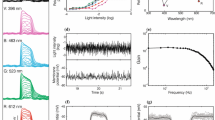Abstract
A hot head gives an insect a clearer view of a moving world because warming reduces motion blur by accelerating photoreceptor responses. Over a natural temperature range, 19–34 °C, the speed of response of blowfly (Calliphora vicina) photoreceptors more than doubles, to produce the fastest functional responses recorded from an ocular photoreceptor. This acceleration increases temporal resolving power, as indicated by the corner frequency of the response power spectrum. When light adapted, the corner frequency increases from 53 Hz to 119 Hz with a Q 10 of 1.9, and when dark adapted from 8 Hz to 32 Hz with a Q 10 of 3.0. Temperature sensitivity originates in the phototransduction cascade, and is associated with signal amplification. The temperature sensitivity of photoreceptors must be taken into account when studying the mechanisms, function and ecology of vision, and gives a distinct advantage to insects that thermoregulate.
Similar content being viewed by others
Author information
Authors and Affiliations
Additional information
Accepted: 2 February 2000
Rights and permissions
About this article
Cite this article
Tatler, B., O'Carroll, D. & Laughlin, S. Temperature and the temporal resolving power of fly photoreceptors. J Comp Physiol A 186, 399–407 (2000). https://doi.org/10.1007/s003590050439
Issue Date:
DOI: https://doi.org/10.1007/s003590050439




